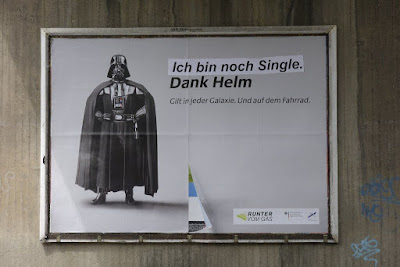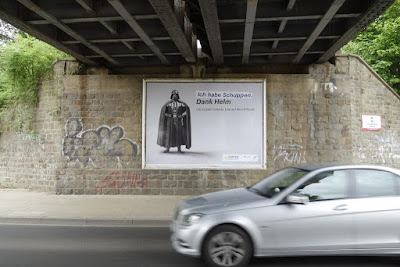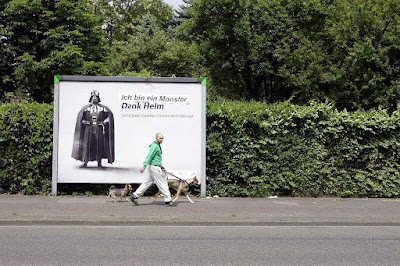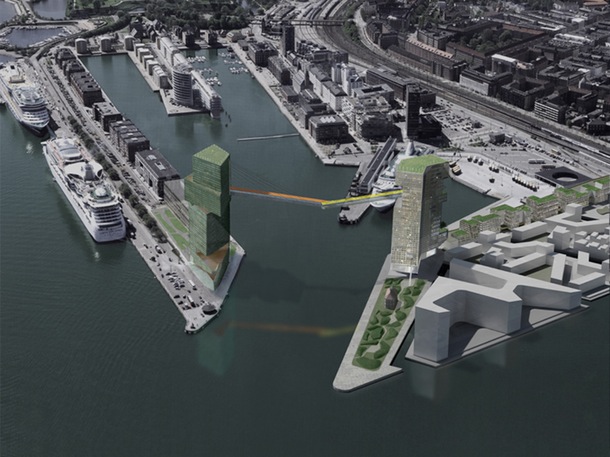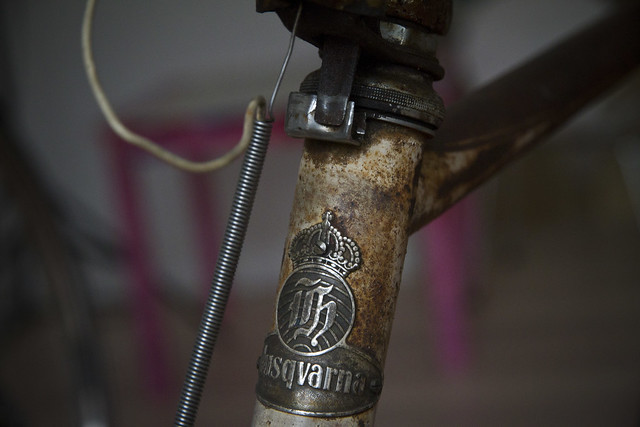The Life-Sized City Blog: Cargo Bikes Are the New Ice Cream Truck
 If you're a regular reader of Copenhagenize, you've probably seen us blog a photo or two of cargo bike vendors. The ice cream bar is, hands down, one of my favorite cargo bikes to see cruising around town. With bicycle culture, and now cargo bike culture, emerging around the world it's refreshing to see examples from cities that aren't Amsterdam or Copenhagen. Here's one straight out of Winnipeg, Canada: The Dickie Dee Ice Cream company.
If you're a regular reader of Copenhagenize, you've probably seen us blog a photo or two of cargo bike vendors. The ice cream bar is, hands down, one of my favorite cargo bikes to see cruising around town. With bicycle culture, and now cargo bike culture, emerging around the world it's refreshing to see examples from cities that aren't Amsterdam or Copenhagen. Here's one straight out of Winnipeg, Canada: The Dickie Dee Ice Cream company.  Having been to wonderful wintry Winnipeg recently for the Kickstand Sessions it's hard to imagine ever getting a hankering for an eskimo pie or a popsicle. Nevertheless, after being founded in 1959, Dickie Dee rode their way to the top - becoming one of the largest vending companies in North America - selling creamsicles and ice cream sandwiches straight from the front of their fiberglass cooler box cargo bikes.
Having been to wonderful wintry Winnipeg recently for the Kickstand Sessions it's hard to imagine ever getting a hankering for an eskimo pie or a popsicle. Nevertheless, after being founded in 1959, Dickie Dee rode their way to the top - becoming one of the largest vending companies in North America - selling creamsicles and ice cream sandwiches straight from the front of their fiberglass cooler box cargo bikes.
Here's to hoping we hear a few more of those handle bar bells jingling around town.
Read More

The Life-Sized City Blog: Hacking a German "Safety" Campaign with Rationality
Billboard in Bonn: "Now I'm single... thanks, helmet."
Photo: Jochen In a country where only about 10% of cyclists wear plastic hats, the Ministry of Transport decided to chuck some taxpayer money into a campaign. A lazy move from politicans whose ignorance about the importance of encouraging cycling, building infrastructure and the health benefits of a cycling population has now been broadcast to the planet. They are basically using taxpayer money to advertise how ignorant they are. There's the first problem with their campaign.
The choice of Darth Vader is as strange as it is awkward - for the Germans. World War II Nazi helmets were the direct inspiration for Vader's helmet, as you can read here:
"Costume designer John Mollo took it from there, fusing elements of various real-life uniforms associated with war and evil. To design Vader’s infamous black helmet, Mollo looked to the black, shiny headgear Nazis wore during WWII."
One might argue that Mr Vader is not exactly an appropriate role model. One of the first things his mentor, Mr Hitler, did when assuming power was make Germany's largest cyclist organisation illegal. (they were also socialists, which was handy).The Ministry also willfully ignores the advice of the European Council of Ministers of Transport in 2004 - which included the German Minister of Transport at the time - in a report entitled National Policies to Promote Cycling:
"[...] from the point of view of restrictiveness, even the official promotion of helmets may have negative consequences for bicycle use, and that to prevent helmets having a negative effect on the use of bicycles, the best approach is to leave the promotion of helmet wear to manufacturers and shopkeepers. The report entitled 'Head Injuries and Helmet Law for Cyclists' by Dorothy L. Robinson, Bicycle Research report No. 81 (March 1997) shows that the main effect of the introduction of the general helmet law for cyclists in Australia was a drop in bicycle use."
Even research from the German Hannelore Kohl Stiftung was happily swept under the rug:
Be sure to check www.motoringhelmet.com for more reasons why driving with a helmet is a good idea. It links to our blog articles about the subject.
Imagine. The Ministry of Transport in Europe's largest country completely and utterly Ignoring the Bull in Society's China Shop.
But hey. Shortly after appearing, billboards around Germany that featured the Darth Vader campaign began to feature added text. The Force is strong within the rational Jedi fighting for liveable cities... The saga continues in Bonn. This billboard now reads: "I have dandruff. Thank you, helmet."Photo: Jochen
Bonn: "I am a monster. Thanks, helmet."Photo: Jochen
 And from Frankfurt: "Works in every galaxy. And on stairs."
And from Frankfurt: "Works in every galaxy. And on stairs."
Photo: Heppo
 Frankfurt: "Works in every galaxy. And in the shower."
Frankfurt: "Works in every galaxy. And in the shower."
Photo: A friend of Jochen Erdelmeier
 Frankfurt: "Works in every galaxy. And while doing housework."
Frankfurt: "Works in every galaxy. And while doing housework."
Photo: Heppo
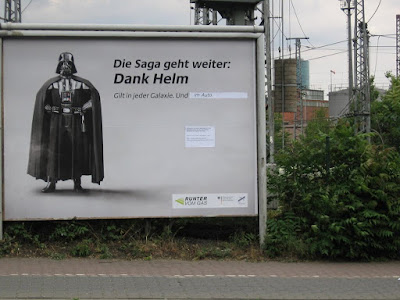 Frankfurt: "Works in every galaxy. And in cars."
Frankfurt: "Works in every galaxy. And in cars."
Photo: Heppo
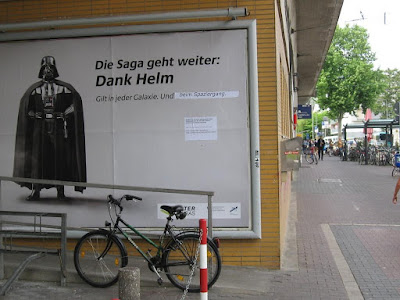 Frankfurt: "Works in every galaxy. And while walking."
Frankfurt: "Works in every galaxy. And while walking."
Photo: Heppo
Read More

The Life-Sized City Blog: New Elevated Cycle Track in Copenhagen - 65 metres high
Update: 17 November 2015
We recieved an email from Steven Holl Architects about this crazy project.
Dear Mr. Colville-Andersen,
I hope this message finds you well. Upon reading your article on Steven Holl Architect’s project in Copenhagen, Copenhagen Gate, Gate L & Gate M, I’d like to clarify concerning cyclists using the new bridge. Though it was initially requested by the city that bridge be for cyclist use, as the design now moves forward it is no longer to be used for cyclists and alternative solutions are being pursued.
All my best,
Kristen Tivey
Press and Archive Coordinator
It appears that the city will not follow up on its original tender requesting a design for a bridge between the towers and certainly not one that will accommodate bikes. Which is a good thing. Scroll to the bottom of this article to see a simple idea that could be upgraded with modern designs. ----
Then, today (26 November 2015), this article appeared in the Danish paper, Politiken. Basically, the latest and possibly last word on this project is that there might be a bridge, but it will be private, not public. Too many challenges with keeping an aerial cycle track open to the public 24/7. The City is looking at other options. The towers will be built, but the goofy flying cycle track ain't gonna be all that.
-----------Copenhagen has built or is building seven new bicycle bridges. In Copenhagen, they're called bicycle bridges, but we assume that there will also be pedestrian access - and there always is. But in the City of Cyclists, our perception is that a bridge ain't functional if it isn't for bicycles. The news here is that yet another bridge has gotten the go ahead. If the elevated cycle track we call the Bicycle Snake / Cykelslangen captured our imagination, have a look at the new kid on the block, above. A covered bicycle and pedestrian walkway 65 metres above the harbour. Leading from one tower to another.
American architect Steven Holl won the competition for Marmormolen - or Marble Pier - back in 2008 but the financial crisis slowed stuff down in Denmark for a while. Now the project is green-lighted. This project is called LM Project.
The towers will be built at the head of the part of the harbour that houses the world's third-busiest cruise ship port. The height of the elevated facility is due to the massive size of most (horribly unsustainable) cruise ships. At first glance one might think either "why bother" or "goofy gimmick", but the elevated cycle track and walkway wasn't an architect's whim. It was actually in the City of Copenhagen's tender material when the project was launched. A tower on each side connected by a bridge at least 65 m in the air. The reason is logistics and city policy. There has to be maximum of 500 metres from any home in Copenhagen to public transport, be it a bus stop, train station or metro station. If you look at the map, above, you can see that the tower on the right, at the end of Langelinie pier, would be much farther away from Nordhavn train station and the coming metro station, at left. If you had to walk or ride a bike all the way around. Therefore, with the elevated facility, people in the tower on the right will be within 500 metres of the stations and bus stops. Personally, I think it's a bit wild, but I know that it is necessary to stick to the fine policy of access to public transport. It will never be a main route for any great number of cyclists or pedestrians but it will be an important connection as the city continues to grow. It still adheres to the basic principles of Danish Design: Functional, Practical and Elegant. Okay, maybe it lacks thorough practicality - taking a large, bicycle-friendly elevator up to the clouds to cross a harbour head is not exactly a smooth, efficient transport flow. But the function as a link across the water is clear. Construction of the buildings and elevated facility will commence in 2016.BUT...

After digesting the news of this bridge, we wonder if it really is the best solution. Like so much else, cool stuff has already been invented. Look at the Puente de Vizcaya in Bilbao, dating from 1893. Same issues were tackled. Large ships passing by and yet the need to connect two shores. Four million people use this bridge every year. It takes a minute and a half to glide from one side to the other. There is no way that the Copenhagen solution, above, is going to take 90 seconds. Once again, a simpler solution has already been invented and has worked fine for over 120 years. We started this article with a reserved level of enthusiasm and then ended up with a feeling of WTF.
Read More

